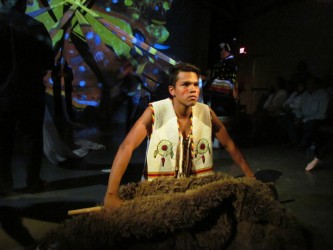Article Origin
Volume
Issue
Year
Using art, Springbank school and Strathmore High School students expressed their empathy for those who endured residential schools, signifying a new beginning.
“They are all part of my own healing. I thank them for that. They give me a strong sense of hope,” said Sheldon First Rider, who had attended St. Mary’s. First Rider was one of several guest speakers at the Reconciliation . . . Towards a New Relationship event June 17, presented by the Calgary Aboriginal Urban Affairs Committee to celebrate works that seek to build positive relations between Aboriginal and non-Aboriginal citizens.
Under First Rider’s guidance, the Springbank students created and displayed visual pieces that expressed their interpretation and understanding of the experience of those forced to attend residential schools and surrender all ties to their culture.
The reconciliation event, presented during Aboriginal Awareness Week in Calgary June 15-21, was spurred by the recently released Truth and Reconciliation Commission’s summary report and its 94 recommendations.
“This is an opportunity to advance greater understanding of where we come from, a shared understanding to move forward. It doesn’t right the wrongs of the past, but allows us to create the future together,” said Mayor Naheed Nenshi.
While National Aboriginal Day is marked on or near the summer solstice in cities across the country, Calgary dedicates an entire week to honouring, recognizing and celebrating Aboriginal culture at a variety of events, hosted by Aboriginal and Métis-serving agencies.
Students of Strathmore High School then presented New Blood, a theatrical performance that tells Siksika Chief Vincent Yellow Old Woman’s personal story through a combination of traditional Aboriginal and modern dance, drumming, poetry and song to the lyrics of Peter Gabriel, with a backdrop of the artwork of George Littlechild.
“Everything conceivable you can think of happened to me,” said Yellow Old Woman. What he remembered most were words spoken by government officials in reference to the purpose of the residential schools, words he hoped would be addressed in song. When Strathmore High School teacher Dianne Bertsch consulted with him in the early development of the production, he shared these words with her.
“To kill the Indian in the child,” were the words spoken in parliament that haunted Yellow Old Woman. He said that he could have been a bitter man, but learned to forgive. “It all has to start from here,” he said, his hand on his heart. “I think you will be touched by what you hear tonight.”
Hayden Cutter, Yellow Old Woman’s grandson, plays the central role of the Chief in the production.
In his closing remarks Wilton Good Striker, an advocate for youth, said that throughout his journey, including work with the national parole board for the past 20 years, he discovered the most successful programs are those that help young people be proud and provided them with identity; something that helped them to regain personal pride; and a reconnection to a spiritual way with a higher power. In his view, the road to healing follows recovery, restoration, renewal, and doing the right thing.
“When all those things happen, there can be reconciliation,” said Good Striker. “It took a long time to create the situation and it will take a long time to recover.”
Photo caption: Hayden Cutter, grandson of Chief Vincent Yellow Old Woman, plays the lead in New Blood performance.
- 1162 views

